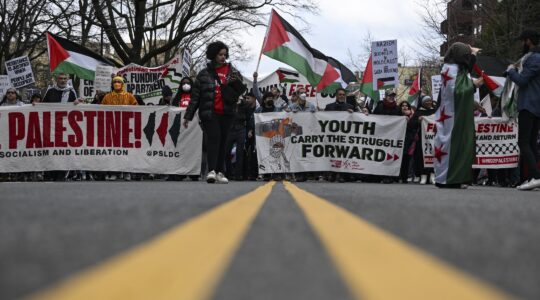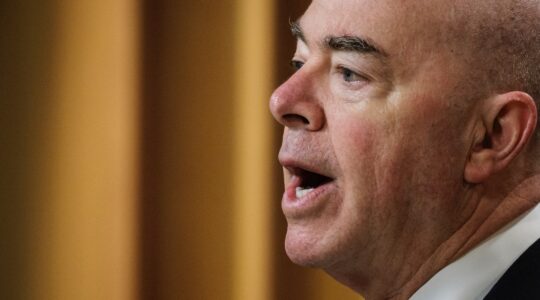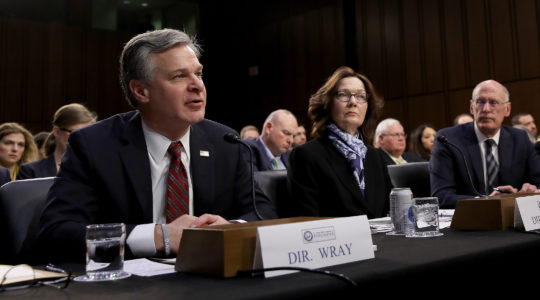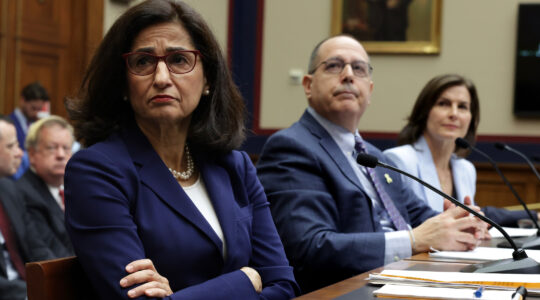PISCATAWAY, N.J. (JTA) – Sitting in a meeting room in the Radisson Hotel here, 15 Orthodox cantors listen reverentially to a 1954 recording of the great Israeli cantor Leib Glantz singing the haunting Selichot service.
The album is somewhat scratched and recorded in mono, but the powerful, plaintive voice mesmerizes the cantors. One or two moan with emotion.
It is not an inappropriate sound at last month’s annual conference of the Cantorial Council of America, the professional association for Orthodox cantors – the few that are left, that is.
While the Reform movement’s American Conference of Cantors boasts 450 members and the Conservative Cantors Assembly approaches 550, just 125 cantors belong to the Orthodox association.
Even that figure is deceptive: Many are retired or hold very part-time positions. Almost none make a living at the cantorate, even those employed full-time. Their business cards carrying the names of real estate offices and computer companies tell the real story.
Orthodox congregations in America just don’t hire cantors.
Cantor Bernard Beer, the director of the Belz School of Jewish Music at Yeshiva University, says that fewer than 5 percent of U.S. Orthodox synagogues have cantors. That’s not the case in Europe or Canada, he says, where Orthodox cantors are more widely used.
A generation ago, there were more than 30 Orthodox cantors in Brooklyn; today there are three. Manhattan also has three.
It’s a far cry from the golden age of chazzanut – or chazzanus, as most of the Orthodox cantors would refer to their leadership of services – when the great cantors of Central and Eastern Europe set sail for America in the years between the two world wars.
“Yossele Rosenblatt, Mordechai Herschman, Zavel Kwartin – they all came around 1921,” Beer says, listing some of the big names in the business. “They made big money. It was the means of entertainment for Orthodox Jews.”
The 1930s Depression put an end to big salaries, but even into the mid-1960s Beer says he’d open Jewish newspapers before the High Holidays and see “pictures of all the chazzans, in their high hats, this one singing at this shul, that one at the other.”
The 1960s, with its anti-establishment ethos and changing musical tastes, affected the Orthodox cantorate as much as the Conservative and Reform, with an added caveat: The congregations were filling with yeshiva and day school graduates who could lead services on their own.
“Here in New York, volunteer laymen have taken over the services,” says Beer, who recalls having “no problem” finding work when he became a cantor in 1965.
Outside New York, he says, most Orthodox congregations are too small to afford cantors.
Another problem is the increasing popularity of the music of the late “singing rabbi,” Shlomo Carlebach, whose tunes have permeated Orthodox synagogues and supplanted traditional nusach, or cantorial chanting.
The demise of Orthodox cantors has been accompanied by a rising interest in concert chazzanut. Some cantors supplement their pulpit incomes by performing onstage. The most famous, such as Yitzchak Helfgot and Moshe Stern, command top dollar at venues including New York’s Lincoln Center.
“People who say they don’t like chazzanut will go to a Helfgot concert,” laments Joel Kaplan, the president of the Cantorial Council of America and the cantor at Congregation Beth Sholom in Lawrence, N.Y.
Most cantors don’t see the popularity of cantorial music onstage spilling over into shul.
“I see the handwriting on the wall,” says Benzion Miller, the longtime cantor of Young Israel/Beth-El of Borough Park in Brooklyn, who says his own concert schedule has dwindled rather than grown in the past few years.
“I’d like to see shuls turn around and start hiring cantors. I’d like to say it will get them more members, but I know that’s not true,” he says. “I only hope that by the time they turn around, there will be cantors to fill the positions.”
Few young men are going into the Orthodox cantorate. The Belz School, which has 150 students, graduates just one or two cantors each year. Most of its students are not on the cantorial track.
The few who are on that track are highly motivated.
Berel Zucker, 27, received his diploma last year and is now the cantor of the Chabad Jewish Center of Southampton, N.Y. Not only is chazzanut in his blood – his father was a cantor, and his entire family has musical talent, he says – but as a Lubavitcher, he looks at the cantorate as his personal shlichus, or mission in life.
“It’s a powerful tool for bringing Jews close to their tradition,” he says.
Even Zucker serves his congregation only once every three weeks. He cobbles together a living by preparing bar mitzvah students, giving voice lessons and leading services in other synagogues on his weekends off. He also sings at weddings.
In a bid to stimulate interest in cantorial skills, the Belz School and the Cantorial Council of America have begun sponsoring workshops to teach nusach to laymen, and to introduce the public to great cantorial music.
The school runs Internet courses for students who can’t move to New York and tries to inculcate an appreciation of the cantorate among the rabbinical students who take its classes.
In 2006, Beer and Cantor Sherwood Goffin, who has been serving Manhattan’s Lincoln Square Synagogue for 43 years, released “Be a Baal Tefillah,” a CD that teaches laymen the Shabbat service in both Ashkenazic and Sephardic pronunciation.
Despite the difficulties, Zucker says he would never discourage cantorial students.
“Some of the people who come to me don’t have great talent and probably won’t become a cantor,” he acknowledges. “But who am I to stand in front of someone’s passion?”





